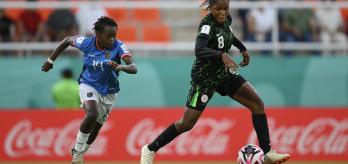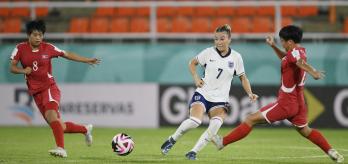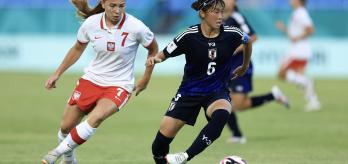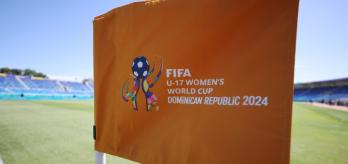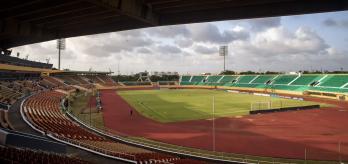In an era of much change, a more traditional approach can be interesting, and in this article, Vanessa Bernauer highlights how Japan used their full-backs to support their attacking play during their FIFA U-17 Women’s World Cup 2024™ quarter-final clash with England.
“So often these days, we see full-backs inverting or making inside runs so it was nice to see them working in a more traditional way. In the first half, Japan had a clear strategy of getting their full-backs high, but it was the timing of their runs from deep positions that was particularly interesting as well as the frequency of them. The commitment and work ethic from right-back Yuna Aoki (2) and Haruko Suzuki (6) to keep making these runs, even when they did not get the ball, was impressive," Bernauer noted.
With Japan’s wingers playing narrower, and locking in England’s full-backs, there was space in the wide areas for Aoki and Suzuki to receive the ball outside their opponent’s team shape. Both players ranked in the game’s top three in this metric, with Aoki receiving 35 times while Suzuki had 37 receptions outside England’s team shape.
During the match, 73% of Japan’s final third entries came in the outside channels, with a total 21 on the left and 26 on the right. They also had more receptions of the ball in behind England’s defensive line in these channels (9 on the left and 6 on the right) than in the inner channels. When we zoom in on who was making these entries and line breaks, the impact of the two full-backs really comes to light.
Between them, Japan’s full-backs were involved in 11 possession sequences that led to attempts at goal, with Aoki (2) ranked joint highest with six, while Suzuki registered five. In addition, both full-backs were involved in the possession phases leading up to both of Japan’s goals.
Timing of runs
While Japan’s full-backs demonstrated a real willingness to get forward, they did so with consideration and purpose. At times their runs were made with the intention of receiving the ball, while on other occasions they were designed to create space for others by dragging opposition players with them.
As Bernauer explains, “Aoki and Suzuki were tireless in their willingness to make these runs for their team. They were always ready and were constantly reading the game, showing a real understanding of when to hold their run and when to accelerate. They recognised where the space was in relation to the player in possession of the ball, and fully committed to the run at high intensity once they understood when to go, getting into great positions.”
In clip 1 below, we see great examples of the forward runs by both full-backs. The judgement by right-back Aoki on when to fully accelerate to get in behind the player tracking her demonstrates a high level of game understanding.
In clip 2, we see a slightly different scenario, whereby Aoki recognises the space left vacant as her wide forward plays narrow, adopting a high position that facilitates a defensive line break.
Physical demands
Both Aoki and Suzuki were very aggressive in their forward runs to join and support their team’s attacks. Since England’s full-backs were locked in and kept occupied by Japan’s wide forwards, the runs by the two attacking full-backs demanded that England’s wingers tracked these runs to prevent 2v1 overloads against their full-backs.
Right-back Aoki was the highest ranked player in the game for zone 4 (19-23km/h) speed runs, registering 58 in total, while she also covered the second highest distance (119.2 metres) when high-speed sprinting (zone 5: >23km/h).
Suzuki also made a significant contribution in this respect, with 53 zone 4 speed runs, and Bernauer was impressed with the diligence and physical commitment of both players.
“The attitude to keep making those runs was excellent from these young players. It asked the opposition wingers to match their work rate, and they knew they could capitalise if their runs were not matched. They were aware that not every run would be successful, but this never deterred them from making them. The mindset for a young player to keep making these runs in the heat was very impressive, because doing that consistently in a game is tiring and demanding. It must be noted that these were often long runs over big distances, and they did it repeatedly.”
An example of the long distances that were covered, and the speed at which they were made, can be seen in clip 3 below. As soon as Aoki recognises the forward pass to her right winger is imminent, she starts to make the fast run from inside her own half. She is not tracked, and therefore creates a 2v1 situation against England’s left-back before making a final third entry.
Individual attributes
The individual attributes of players are important when coaches are designing match strategies and assigning roles and responsibilities. It was clear in this game that the skills and strengths of both full-backs were considered, because they each brought different attacking dimensions to their team’s wide-area play, and therefore different challenges for their opponents to manage.
According to Bernauer, “Both full-backs had different attacking strengths and this added to the challenges they could pose to their opponents in the final third. Right-back Aoki (2) is extremely direct when she gets on the ball, and at times, I thought she was faster with the ball than without it, such was the speed she could generate. Left-back Suzuki (6) really loved to go 1v1 and take players on and she had great ability to beat defenders and put crosses in. As young players, they will continue to grow and will add more quality to their game, but they already have many positive attributes to build on.”
Right-back Yuna Aoki (2)
As a defender, Aoki’s impact on Japan’s attacking play was notable. Not only did she score one of their two goals, but she registered more attempts at goal than any other player. She was also involved in the six possession sequences that led to attempts at goals and was the second-highest ranked player for offering to receive in behind her opponent’s defensive line and outside of their team shape (with 9).
She made the most high-intensity runs (zone 4) in the game and was ranked joint top in the game for combined high-speed runs (zone 4) and sprints (zone 5) with a total of 67. Her high-speed runs brought physical intensity and her direct running style, with and without the ball, helped her to create and occupy space in the wide areas. As can be seen in clip 4 below, when she entered the final third, she had the confidence and technique to drive towards goal, creating genuine goalscoring opportunities for her team.
Left-back Haruko Suzuki (6)
On the left side, Suzuki (6) added a different threat to Japan’s attacking repertoire with her desire and ability to go 1v1. She broke the opposition’s defensive line four times in this game, (more than any other player) and she also performed the most ball progressions with a total of four (3 step-ins, 1 take-on).
When carrying the ball, she had good close control even when running at speed, making her a difficult opponent for opposition defenders, who were also being occupied by Japan’s forwards. She played a high-intensity game but also had the intelligence to recognise where her teammates were in the penalty area when judging her opportunities to cross the ball.
As can be seen in clip 5 below, she recognises the opportunity to move into space on the opposite side of the pitch as her team tries to build an attack. Once she receives the ball, she drives forward with intent, bypassing an opposition defender as she enters the final third. Recognising she has runners to the back post area, she lofts her cross, making it very difficult for the goalkeeper to get a clean catch before Hina Hirakawa (20) scores their second goal.
Key take-aways
Japan’s full-backs brought an impactful attacking dimension to their team’s wide-area play with commitment, tireless running and attacking technique in the final third. The key characteristics of their performance included:
- Making consistent, long, forward runs at high speed to create space or to receive the ball
- Mentality to sustain the work rate, even when runs were unsuccessful
- Creating additional opportunities to enter the final third
- Timing of their runs to get in behind the opposition’s defensive line
- Being direct when in the final third, generating goal-scoring opportunities.






















